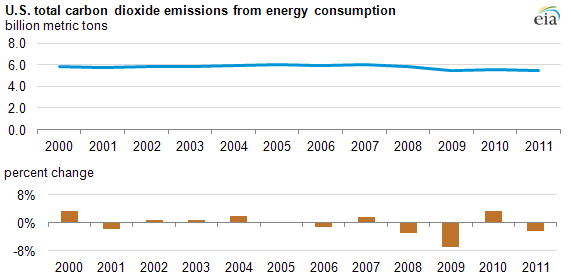
Energy-related carbon dioxide emissions down in 2011

Download CSV Data
Annual energy-related carbon dioxide (CO2) emissions fell 2.4% in 2011 compared to the level in 2010. Several factors combined to produce this drop, including slower economic growth, weather, and changes in the prices of fuels, which played out differently in major economic sectors. Energy-related carbon dioxide emissions have declined in the United States in four out of the last six years.
Economic growth as measured by gross domestic product (GDP) increased by 1.8% in 2011, slower than the 2.4% growth in 2010. Year-to-year emissions changes often reflect the level of economic activity, as fossil fuels are used across much of the economy.
Because the decline in CO2 emissions occurred in a growing economy, the carbon intensity of the economy fell. This was mainly a result of using less energy or, in some cases, using less carbon-intensive energy, to achieve the same economic output.
Weather was a factor in reducing the energy intensity of the economy. Warmer temperatures in the summer of 2011 resulted in a modest increase in the amount of energy required for cooling, but the relatively mild winter brought a significant drop in the amount of energy required for heating. The net result was a decrease in the consumption of energy in the residential sector where weather influences energy consumption for heating and cooling.
Changing prices for fuels also had a role in the decline in CO2 emissions in 2011. The transportation sector was affected by a 27% increase in the price of gasoline. Coincident with the price increase was a 1.0% increase in the miles per gallon of light duty vehicles and a 1.2% drop in vehicle miles traveled. These factors combined to decrease transportation energy use by 1.4% in 2011.
Changing fuel prices and the resulting changes in fuel use drove down the carbon intensity of the fuels used to produce electricity in 2011. Electric power generation from natural gas, the least carbon intensive of the fossil fuels, increased by 3%, while generation from coal declined by 6%. Natural gas has approximately one-half the carbon of coal. Power generation from renewable sources continued to rise, mostly because of record-breaking supplies of hydroelectricity and increasing generation from wind, solar, and other renewable sources.